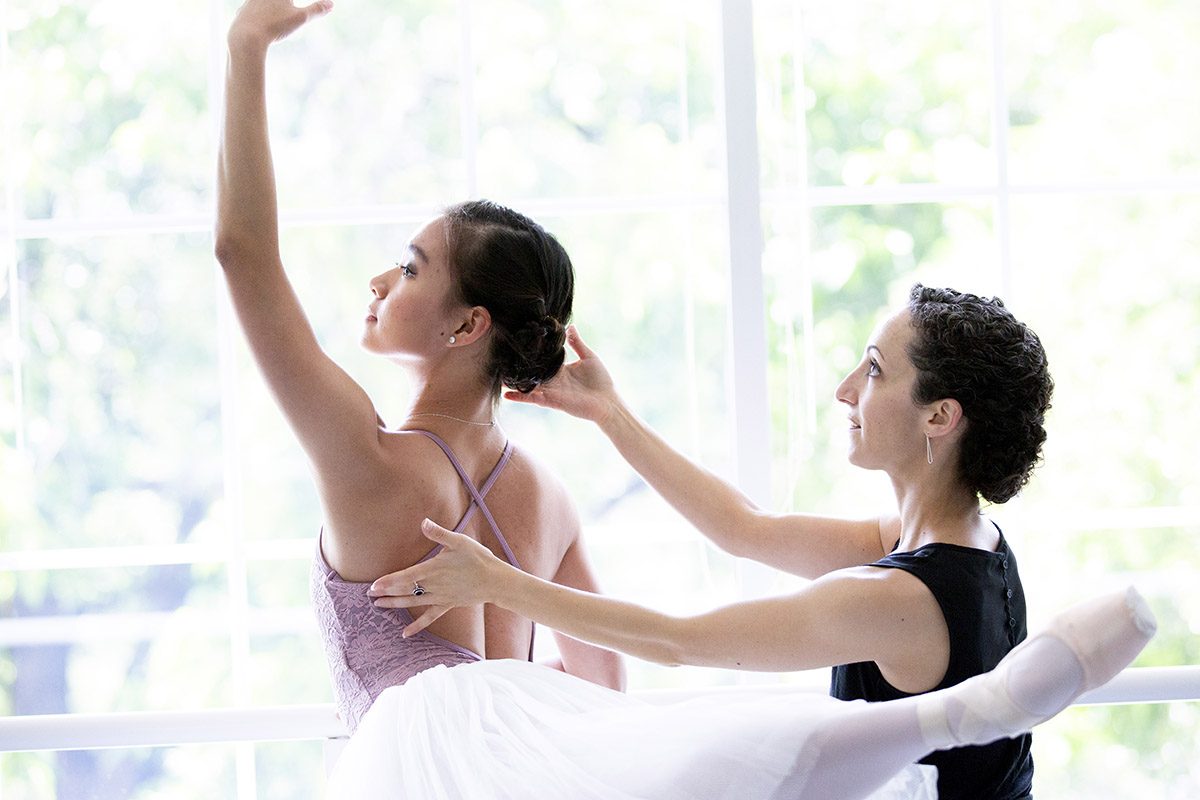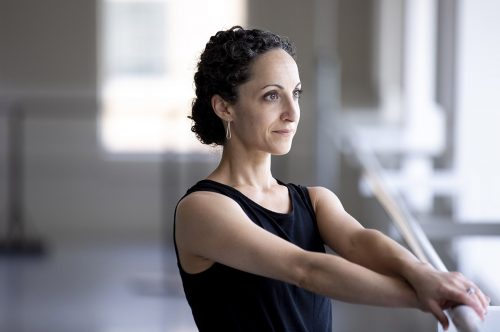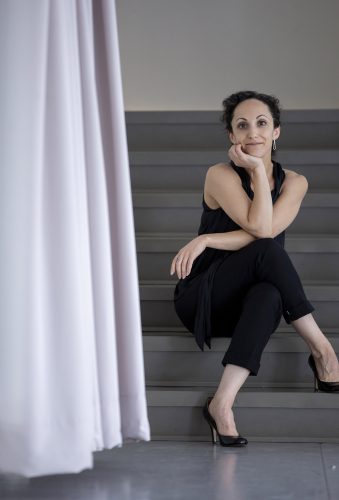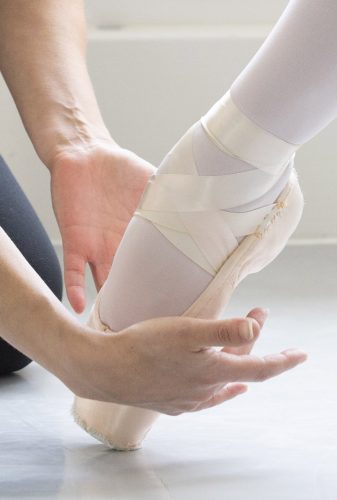
Making the Mind-Body Connection in Dance
Jessica Zeller values student input and critical thinking over rote mimicry.
Championed in the U.S. beginning in the 19th century by philosopher John Dewey, progressive education prioritizes student engagement in the learning process. In 2019, the tenets of progressive education have made their way into almost every arena of American education.
Except when teaching ballet.
In the centuries-old art form, the adoption of progressive-education principles has been “slow going,” said Jessica Zeller, associate professor of dance and author of Shapes of American Ballet: Teachers and Training before Balanchine (Oxford University Press, 2016).

Jessica Zeller’s 2016 book, Shapes of American Ballet, explores training methods employed before George Balanchine, the “father of American ballet.” Photo by Joyce Marshall
In a 2017 Journal of Dance Education article, Zeller outlines some shortcomings of the teacher-centric model in ballet classes and suggests an alternative studio environment that gives voice to the students. She advocates for valuing the experience specific to each student’s body and emphasizes learning heightened by thoughtful reflection.
“Within the classical pedagogical model, the instructor has all the knowledge and can assume each student is taking the same thing away because [the instructor] is not engaging with them on an individual level,” Zeller said. “The students are silent. The teacher tells them exactly what to do, and they do it with the utmost level of dedication. No questions asked.”
Zeller, who received a TCU Deans’ Award for Teaching in 2018, is among a growing body of dance researchers who are aware of the important relationship between mind and body. Still, she said, many instructors in the field see no reason to change the old repeat-after-me paradigm for one simple reason: It works.

Ludvina Theodor, a junior ballet and accounting major, dances with Jessica Zeller in Erma Lowe Hall. In Zeller’s class, dance involves much more than mirroring in silence. Photo by Joyce Marshall
“It does work. It does produce dancers,” Zeller said. “But in academia, and at TCU especially, we’re trying to educate a whole person and not just a body. That’s the reason, fundamentally, for all of this — for the adoption of more progressive principles in the studio and for the way I teach my classes.
“In ballet, a form does exist, an ideal exists, and we are all working toward that same ideal. From my perspective, I want to figure out how to get each person moving toward the ideal individually.”
For example: In the traditional teaching model, an instructor demonstrates a pirouette and then tells students to replicate her movements. In Zeller’s class, however, a pirouette involves much more than mirroring in silence. Rather, workshopping the maneuver becomes a lesson in anatomy and biomechanics as well as on the value of failure and honest self-reflection.
“In order to pirouette in a way consistent with the ideal form, certain muscle groups must be recruited through the movement,” Zeller said. “I’ll say, ‘We’re all going to work toward feeling these specific muscles firing,’ but the way each student experiences that will be fundamentally different.

Jessica Zeller uses reflective practice as an essential tenet of progressive education. Photo by Joyce Marshall
“When you close your eyes, the interior landscape of your body is your own, and there’s no way for anyone else to experience that. Students who are offered the space to speak up and actually articulate their experience allow [instructors] to help them in more profound ways. We’re hearing what their experience is, and we’re able to help them shape that experience in a way that gets them closer to the ideal.”
Catherine Roe ’14 recalled a stark difference between ballet studies at TCU and the dance classes she took before college. She described Zeller’s teaching style as “transparent,” meaning the purpose behind the design of the class was always clear.
Roe said that Zeller’s classes began with exercises at the barre chosen to aid the work that would follow. Later in class, Zeller would ask, “Hey, do you remember that exercise at the barre? That’s the sensation you’re trying to achieve as you move this way,” Roe recalled.
“It was never like, ‘I have all the secrets, and I determine when and whether or not I share them with you,’ ” Roe said.
The reflective practice, referred to in Zeller’s article, is an essential tenet of progressive education. It assumes that a substantial part of the work taking place in the classroom is the active reflection — in both formal and informal ways — on one’s actions and experience. In this way, instructors and students alike participate in a process of continual learning and foster developmental insights.

Jessica Zeller positions the foot of Ludvina Theodor, a junior ballet and accounting major. Photo by Joyce Marshall
“There is an emphasis on thinking about the learning that’s happening, an emphasis on being thoughtful about what it is that we do and how we do it, before, during and after any given educational experience,” Zeller said. “It’s about how we prepare, how we reflect in the moment and how we reflect after the fact.”
Nicole Browne ’16 said she admired Zeller’s willingness to tailor her courses to the students’ needs. “[Zeller] would always ask for midsemester assessments where we, as the students, would assess how the course was going for us and how she was doing as the instructor. … Sometimes the syllabus would change midsemester based on that feedback.”
A student’s ability to garner insights from the experience is strongest, Zeller said, when reflection is modeled for them. Students can feel the difference between an instructor who is willing to collaborate in designing and navigating the learning process and one who situates herself miles above.
“I hope the biggest difference when students walk into my classroom is that they’re not afraid of me. They’re not afraid to ask questions, to open their mouths and share something of their own work,” Zeller said.
“I know several of my colleagues at TCU have adopted more reflective practices, and many professors at other universities, I know, are working to help students find their voices in dance. And I mean their actual voices, as in verbalizing their experiences so that when they go out into the field, they are self-assured enough to self-direct. They’re confident enough to take something that’s not working and break it down on their own. They develop an individual sense of agency that supports their work not only in ballet, but in any career path they might choose.”

Your comments are welcome
1 Comment
Great article! Ballet is not the first place I would look for progressive education, but it makes perfect sense.
You might like to see about dance in Nepal schools, where it seems to be more common (and valued?) than in the US. See https://chipbruce.net/2016/11/06/john-dewey-in-nepal/
Related reading:
Alumni
Tina Mullone Choreographs a Dance Career
MFA grad never stops moving as she leaps from ballet to modern to more
Alumni, Web Extras
A Career Tailor-Made for Jennifer Dasher
Jennifer Dasher ’03 has done costume design for Paula Abdul and technical rehearsals for Taylor Swift.
Research + Discovery
Practice Mindfulness for Less Stress and Better Sleep
Students and faculty go with the flow of meditation and mindfulness.